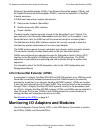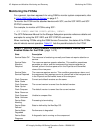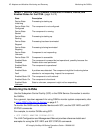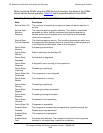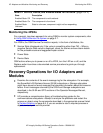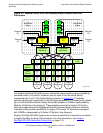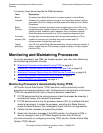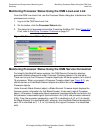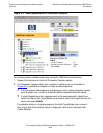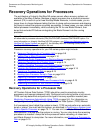
Processors and Components: Monitoring and
Recovery
HP Integrity NonStop NS-Series Operations Guide—529869-005
9-2
Overview of the NonStop Blade Complex
Overview of the NonStop Blade Complex
The basic building block of the modular NonStop advanced architecture (NSAA)
compute engine is the NonStop Blade Complex, which consists of two or three
processor modules called NonStop Blade Elements. Each Blade Element houses two
or four microprocessors called processor elements (PEs). A logical processor consists
of one processor element from each Blade Element. Although a logical processor
physically consists of multiple processor elements, it is convenient to think of a logical
processor as a single entity within the system. Each logical processor has its own
memory, its own copy of the operating system, and processes a single instruction
stream. NSAA logical processors are usually referred to simply as “processors.”
All input and output to and from each NonStop Blade Element goes through a logical
synchronization unit (LSU). The LSU interfaces with the ServerNet fabrics and contains
logic that compares all output operations of a logical processor, ensuring that all
NonStop Blade Elements agree on the result before the data is passed to the
ServerNet fabrics.
A processor with two NonStop Blade Elements comprise the dual modular redundant
(DMR) NonStop Blade Complex, which is also referred to as a duplex system. This
duplex system provides data integrity and system availability that is comparable to
NonStop S-series systems, but at considerably faster processing speeds.
Three NonStop Blade Elements plus their associated LSUs make up the triple modular
redundant (TMR) NonStop Blade Complex, which is referred to as a triplex system.
The triplex system provides the same processing speeds as the duplex system while
also enabling hardware fault recovery that is transparent to all but the lowest level of
the NonStop operating system (OS).
In the event of a processor fault in either a duplex or triplex system, the failed
component within a NonStop Blade Element (processor element, power supply, and so
forth) can be replaced while the system continues to run. A single Integrity NonStop
system can have up to four NonStop Blade Complexes for a total of 16 processors.
Processors communicate with each other and with the system I/O over dual ServerNet
fabrics.
A ServerNet fabric is a complex web of links that provide a large number of possible
paths from one point to another. Two communications fabrics, the X and Y ServerNet
fabrics, provide redundant, fault-tolerant communications pathways. If a hardware fault
occurs on one of the ServerNet fabrics, communications continues on the other with
hardware fault recovery transparent to all but the lowest level of the OS.
Figure 9-1 is an overview of the modular NSAA and shows one NonStop Blade
Complex with four processors, the I/O hardware and the ServerNet fabrics.
Note. This section does not apply to Integrity NonStop NS1000 systems, which use the NSVA
rather than NSAA architecture (see NonStop System Architectures
on page 2-2). For more
information on Integrity NonStop NS1000 systems, see Differences Between Integrity NonStop
NS-Series Systems on page 2-2, the NonStop NS1000 Planning Guide, or the NonStop
NS1000 Hardware Installation Manual.




